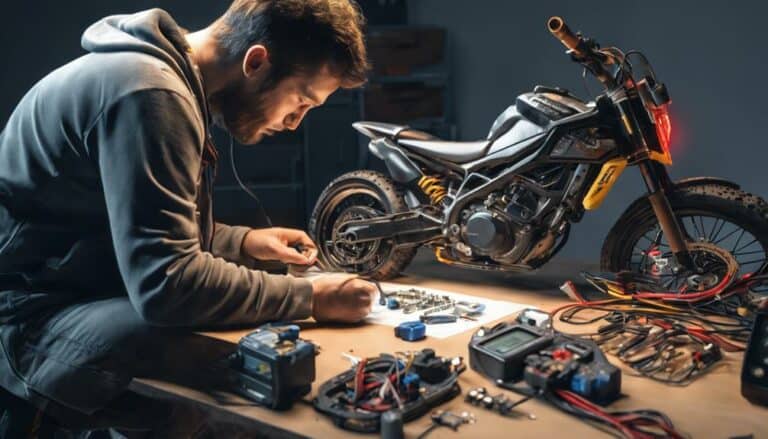To perform a thorough analysis of your dirt bike's electrical system, start with a visual inspection. Check for damaged wires and corroded connections. Test the battery's charge and avoid using incorrect sizes. Utilize an ohmmeter and multimeter for component testing. Confirm the ignition coil and rectifier are functioning correctly. Regularly inspect safety features and troubleshoot with spark and voltage drop tests. Remember, meticulous testing is essential for top performance and reliability.
Key Takeaways
- Inspect wiring for damage and connections for corrosion.
- Test switches, lights, and ignition system for functionality.
- Use ohmmeter and multimeter for component testing.
- Check ignition coil for spark plug ignition voltage.
- Verify safety features and troubleshoot with spark and voltage testing.
Initial Inspection and Visual Checks
When starting the examination of a dirt bike's electrical system, prioritize a thorough initial inspection and visual checks to identify potential issues promptly.
Begin by inspecting the wiring harness for any frayed or damaged wires that could cause electrical malfunctions. Check the connections on the battery, starter, and ignition system, ensuring there's no corrosion or loose fittings that could impede the flow of electricity.
Look closely for any burnt fuses or signs of overheating in the electrical components, as these indicate underlying problems. Test the functionality of switches, lights, and the ignition system individually to pinpoint any faulty components.
Additionally, confirm proper grounding by checking the connection between the negative terminal of the battery and the frame, as a poor ground can lead to various electrical issues.
This detailed inspection will lay the groundwork for a thorough analysis of your dirt bike's electrical system, enabling you to address any issues effectively.
Battery Testing and Maintenance
To effectively maintain and assess the condition of your dirt bike's electrical system, initiating thorough battery testing and maintenance procedures is essential. Before testing, make sure the battery is fully charged to prevent inaccurate results and potential damage to the electrical system.
Avoid using jumpers on old dead batteries as they may not provide accurate readings and can harm the bike's electrical components. Overcharging a battery without proper maintenance can lead to reduced battery life and damage to the electrical system.
Using an incorrect battery size or voltage can cause electrical issues and impact the overall performance of the dirt bike. Always use the correct size and voltage of the battery recommended for the specific model to maintain the best electrical system functionality.
Proper maintenance of the battery is vital for preventing damage and ensuring accurate results when testing the electrical components of your dirt bike.
Component Testing With Ohmmeter and Multimeter
For effective analysis of a dirt bike's electrical system, utilize an ohmmeter to test the resistance of components such as ignition coils, stator coils, and rectifiers. By measuring the resistance, you can determine if these vital parts are within the specified range outlined in the testing specifications.
Additionally, employ a multimeter to check the continuity of wires within the system to make certain there are no breaks or interruptions in the electrical flow. It's essential to refer to the dirt bike's shop manual for the correct testing procedures and specifications when using these testing tools on the components.
For specialized components like ignition coils, utilize testing machines designed specifically for evaluating their functionality accurately. Moreover, a Circuit Tester can be used to check the coils in the electrical system for proper operation and identify any potential issues that may affect the dirt bike's performance.
Ignition Coil and Rectifier Examination
Inspect the ignition coil and rectifier on your dirt bike to guarantee proper functionality and performance of the electrical system. The ignition coil plays an essential role in your bike's operation by converting the low voltage from the battery into high voltage needed to ignite the spark plug. Through electromagnetic induction, the ignition coil boosts the voltage to guarantee efficient combustion within the engine. A malfunctioning ignition coil can lead to issues like misfiring, rough idling, and decreased engine performance. On the other hand, the rectifier converts the AC current generated by the stator into DC current essential for battery charging and overall electrical system functionality. This component safeguards your electrical system by maintaining a steady flow of DC current at the correct voltage levels.
| Component | Function | Importance |
|---|---|---|
| Ignition Coil | Amplifies voltage for spark plug ignition through electromagnetic induction | Ensures efficient combustion |
| Rectifier | Converts AC current from the stator into DC current for battery charging | Protects electrical system |
Safety Features and Troubleshooting Steps
Regularly inspect the safety features and carry out troubleshooting steps to guarantee the peak functionality and reliability of your dirt bike's electrical system. Modern motorcycles are equipped with essential safety mechanisms such as circuit breakers and fuses that play an important role in preventing electrical failures and safeguarding riders from potential hazards.
When troubleshooting electrical issues, it's imperative to conduct spark testing, voltage drop testing, and verify the proper functionality of the kill switch. Remember that altering bulb wattage can have a significant impact on the electrical system; hence, always adhere to the recommended specifications.
Accurate readings from testing tools are essential for effectively diagnosing any electrical problems that may arise. Understanding the ignition system involves thorough spark testing, voltage drop testing, and checking the kill switch for any malfunctions, ensuring that your dirt bike's electrical system operates to its fullest potential and safely.
Conclusion
In summary, by following the outlined steps for analyzing a dirt bike's electrical system, you can guarantee its proper functioning and identify any potential issues.
Remember to conduct thorough inspections, test the battery and components, and examine key elements such as the ignition coil and rectifier.
By prioritizing safety features and troubleshooting effectively, you can maintain the integrity of your dirt bike's electrical system for peak performance on the road or off-road.

